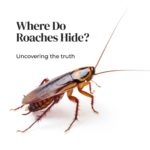Ah, the pesky cockroach. Ever wondered how that stubborn, tiny intruder made its way into your pristine home? Well, let me weave you a tale of the sneaky pathways cockroaches use, and while we’re at it, we’ll dive deep into the strategies to keep them at bay.
Imagine you’re a cockroach (just go with it for a second). The world is vast, and there are so many homes to explore. How do you decide which one to grace with your presence?
List of Entry Points:
- Memory Lane: Sometimes, cockroaches have been around longer than you think! Perhaps they were already partying in your house before you moved in. “Who was here first, huh?” they might say.
- Hitchhiking 101: Cockroaches, like some avid travelers, might have hitched a ride with you from your previous place or even from that luxurious vacation spot. Ever thought of that souvenir you never intended to bring back?
- The Neighbor’s Gift: Let’s face it, if your neighbor isn’t as enthusiastic about cleanliness as you are, their roaches might just venture to see if the grass (or crumbs) is greener on your side.
- Parcel Pals: Receiving parcels? They might come with more than what you ordered. Cockroaches adore cardboard and can easily sneak into boxes.
- The Plumbing Pathway: Much like a certain Italian plumber we all know and love, roaches can come in through your pipes, sewers, and drains. “It’s-a-me, Cockrochio!”
Their Favorite Hideouts:
- Tight Squeeze: These little critters prefer the road less traveled – narrow cracks, crevices, and spaces away from the hustle and bustle of human activity. “Why socialize when you can hide?”
- Dark & Cozy: Think of those dark crevices in your home as luxury resorts for roaches. Especially if it’s close to a water source; that’s like offering them a beachfront view!
- Cardboard Condo: Ever left cardboard around? For cockroaches, it’s the equivalent of a cozy mountain cabin.

A Brief Overview of Roaches
Contents
Cockroaches are insects that have been around for millions of years, with over 4,500 known species worldwide. Some common species include the German cockroach, American cockroach, and Oriental cockroach. Roaches can be found in various environments, from tropical climates to your local neighborhood. These resilient creatures can adapt to a range of living conditions, making them difficult to eliminate once they’ve settled in.
Where Roaches Nest
Understanding where roaches nest is crucial in identifying their presence in your home. Roaches typically hide in dark, damp, and warm places, such as:
- Behind appliances
- Underneath sinks
- In cracks and crevices
- Inside walls
- In cabinets and cupboards
These insects are nocturnal, meaning they are most active during the night when they search for food and water.
What Attracts Roaches to Your Home
Roaches are attracted to various factors in a home, including:
- Food sources: Roaches will eat almost anything, so leaving food crumbs or unsealed containers can attract them.
- Water sources: Leaky pipes and damp areas create the perfect breeding ground for these pests.
- Warmth and shelter: Roaches seek out warm, dark, and secluded spots to hide and breed.
How You Let Them In
Unknowingly, you may be inviting roaches into your home. Common ways roaches enter a living space include:
- Through cracks and crevices: Roaches can squeeze through tiny gaps in walls, windows, and doors. Regularly inspecting and sealing these openings can help prevent their entry.
- Brought in with groceries: Roaches and their eggs can hitch a ride on food packaging. Always check your groceries before bringing them inside.
- On used furniture or appliances: Inspect and clean any second-hand items before bringing them into your home to avoid introducing roaches.
- Through plumbing: Roaches can travel through pipes and enter your home via sinks and drains. Regular maintenance and sealing of gaps around pipes can help prevent this.
- Outdoor entry: Roaches can enter your home from outside through open windows, doors, or vents. Installing screens and sealing gaps can deter these pests.
How to Prevent Roaches from Entering Your Home
Prevention is key when it comes to roaches. Here are some tips to keep them at bay:
- Keep your home clean and clutter-free. Roaches thrive in messy environments.
- Store food in sealed containers and clean up crumbs and spills immediately.
- Fix leaky pipes and eliminate standing water.
- Seal cracks and gaps in walls, windows, and doors.
- Regularly inspect and clean your home, paying close attention to dark and damp areas.
Dealing with a Roach Infestation
If you’ve spotted a roach in your home, it’s essential to act quickly. Consider the following steps to eliminate these unwelcome guests:
- Identify the species: Different roach species require different treatments. Check out guides on German, American, and Oriental cockroaches to help identify the type you’re dealing with.
- Locate their hiding spots: Roaches are good at hiding, but you can find them by looking for signs like roach droppings, egg casings, and unusual odors.
- Use baits and traps: Roach bait gel and roach traps are effective in luring roaches out of hiding and eliminating them. Products like Advion Cockroach Gel Bait are popular choices.
- Apply insecticides: Insecticides like roach spray, borax, and diatomaceous earth can help kill roaches on contact or deter them from entering your home.
- Use natural remedies: If you prefer a non-toxic approach, try home remedies for roaches, such as peppermint oil, baking soda and sugar, or catnip.
- Prevent re-infestation: Continue to follow the prevention tips mentioned earlier to keep roaches from returning to your home.
- Hire a professional: If you’re struggling to control the infestation, consider hiring a roach exterminator. They’ll assess your situation, identify the species, and recommend the best course of action.
FAQ
Q: Can cockroaches fly?
A: Some species of cockroaches have wings and can fly short distances, while others cannot. For example, American cockroaches and Asian cockroaches can fly, whereas German cockroaches are unable to fly despite having wings.
Q: How long do roaches live?
A: The lifespan of a cockroach varies by species, but on average, they live for about a year. Factors such as temperature, humidity, and the availability of food can impact their lifespan.
Q: Do cockroaches bite?
A: Although it’s rare, cockroaches can bite humans. However, they usually only bite when their population is high, and food sources are scarce. Roach bites are not venomous but can cause skin irritation.
Q: What do baby cockroaches look like?
A: Baby cockroaches are smaller versions of adult roaches, typically lighter in color and lacking wings. They can be as small as a few millimeters in length, depending on the species.
Q: How many legs does a cockroach have?
A: All cockroach species have six legs, which are covered in tiny sensory hairs. These hairs help them detect changes in their environment and enable them to move quickly and efficiently.
Q: How can I prevent roaches from infesting my car?
A: To prevent a roach infestation in your car, maintain cleanliness by removing trash, vacuuming regularly, and avoiding eating inside the vehicle. Check for signs of roaches and use traps or insecticides if necessary. For more tips, check out this guide on how to get rid of roaches in car interiors.
Q: Are shrimp and cockroaches related?
A: While they may have some superficial similarities, shrimp and cockroaches are not closely related. Shrimp are crustaceans, while cockroaches belong to the insect class. Their similarities in appearance can be attributed to convergent evolution rather than a shared ancestry.




